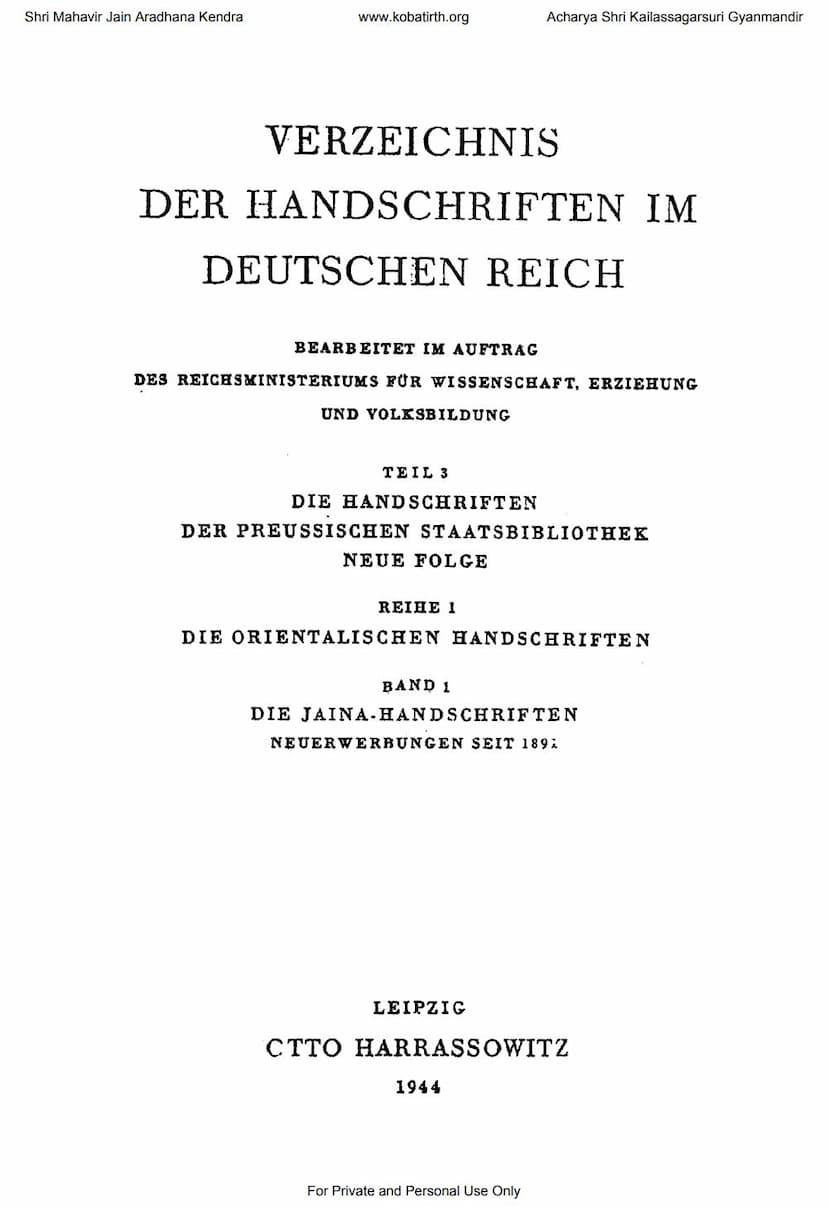Verzeichnis Der Handschriften Im Deutschen Reich Part 01
Added to library: September 2, 2025

Summary
This document is a detailed catalog of Jain manuscripts held in German institutions, specifically focusing on those acquired by the Prussian State Library in Berlin after 1891. The work, titled "Verzeichnis Der Handschriften Im Deutschen Reich Teil 3: Die Handschriften Der Preussischen Staatsbibliothek Neue Folge Reihe 1 Die Orientalischen Handschriften Band 1 Die Jaina-Handschriften Neuerwerbungen Seit 1891", was published in Leipzig by Otto Harrassowitz in 1944 (though the preface and some dated entries indicate earlier creation dates, with a primary publication year of 1941 also mentioned). The text was compiled under the editorial direction of Gunther Weibgen and written by Walther Schubring.
The catalog meticulously lists and describes 1127 Jain works found in 770 manuscript volumes. It aims to be a continuation and updating of Albrecht Weber's earlier work on the Königliche Bibliothek zu Berlin's Sanskrit and Prakrit manuscripts.
Key aspects and information presented in the catalog include:
- Scope: The catalog covers Jain literature acquired by the Prussian State Library from 1891 onwards, excluding non-religious works. It includes both paper manuscripts (primarily from North India) and a collection of 642 South Indian palm-leaf manuscripts acquired in 1919.
- Organization: The manuscripts are systematically categorized, with the main sections being:
- A. Canonical and Non-Canonical Texts (comprising Angas, Upangas, Painnas, Cheyasuttas, Nandi, Anuogadara, Mulasuttas, and texts outside the canon).
- B. Myth and History (including general topics, legendary and historical persons).
- C. Practical Life (covering general aspects, lay practices, and specific individual duties).
- D. Cult and Ritual (detailing cult images, rituals like vidhi and pūjā, mantras, and festival observances).
- E. Hymns (Stotras on persons, places, and sacred texts).
- F. Dogma (covering general doctrines, dialectics, apologetics, specific topics like souls, karma, cosmology, and ethics).
- G. Ethics (collections of ethical works and sayings).
- H. Legends (legends of groups and individuals, and spiritual objects in titles).
- Appendices include geographical data, dates, standing numbers, and lists of works and persons.
- Descriptive Elements: Each manuscript entry typically includes:
- Accession number (Akz.-Nr.) and manuscript number.
- Number of leaves.
- Dimensions of the manuscript.
- Dating information (often the year of creation, writer, and location).
- Script (e.g., older script, younger script).
- Number of lines per page.
- Title of the work and any marginal titles (Randt.).
- Language (Sanskrit, Prakrit, Gujarati, Hindi, Apabhramsa).
- Estimated number of granthas (a unit of verse).
- Mention of printed versions, if available.
- Information about the author, including their lineage or school.
- Description of illustrations or illuminations.
- Specific details about the text's content or its relation to other manuscripts.
- Notes on the physical condition or any additions by later hands.
- Methodology: The catalog follows modern principles for manuscript descriptions, aiming for clarity and conciseness, and prioritizes presenting what should be in the text (orthographically correct form) rather than slavishly reproducing errors, as was common in older cataloging. Transliteration aims for correct orthography.
- Key Information Highlighted: The preface and the detailed descriptions reveal the significant presence of Svetambara literature, particularly in Gujarati, but also substantial collections from the Digambara tradition. The catalog also notes the importance of these manuscripts for language studies (especially Prakrit) and for understanding Jain religious history, rituals, and philosophy. It acknowledges the ongoing need for critical editions of canonical texts.
- Collaborators: The work benefited from the assistance of Dr. Jehangir C. Tavadia and Professor Ludwig Alsdorf in verifying textual details.
In essence, this is a scholarly, foundational work for anyone studying Jainism, its literature, and the history of its transmission, providing an invaluable resource for identifying and accessing a vast collection of Jain manuscripts.